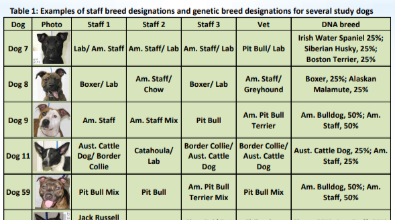There are three types of lies in this world. Lies, damn lies, and statistics.
What are statistics?
Statistics are defined as numerical data and is the field of math that deals with the collection, tabulation, and interpretation of numerical data. So it is pretty much a way to take something and assign a numerical value to it. This is what we do to dog bites. We consider how many dog bites, who is bitten and who is doing the biting. Seems pretty simple, right? You get those three, and you can tell who is doing all the damage in the community. But there are problems with this.
Which breeds are doing all the biting?
As we have discussed before, there is no easy way to identify a pit bull because it is not a breed. It is a type of dog! Even professionals are not able to identify a pit bull just from looking at them.

University of Florida: Maddie’s Shelter Medicine Program:
College of Veterinary Medicine conducted a national survey of dog experts to compare their best guesses for the breeds of dogs in a series of photographs. These visual assessments were compared to DNA breed profiles for the dogs. More than 5,000 dog experts, including breeders, trainers, groomers, veterinarians, shelter staff, rescuers, and others completed the survey. Guess what they found? These experts were not able to always identify the dogs correctly!

Maddie’s Fund did another survey, and they found that when looking at DNA analysis, most of the shelter staff guessed about the dog breed were incorrect. DNA identified about 1 out of 5 dogs to be Pit Bulls, and the shelter staff identified 1 out of 2 dogs! That means that the shelter staff labeled dogs as Pit Bulls when they were not!
Lack of consistency among shelter staff in breed assignment suggests that visual identification of pit bulls is unreliable. So, if experts in the field are not able to identify a dog correctly, what makes us think that your average Joe can?
Dog bites are traumatic!! They are a horrible experience for a person. In that state of mind, how can a person correctly identify the dog that bit them? And with so many news stories talking about Pit Bulls, it is no wonder that these people automatically think of a Pit Bull type dog as the attacker.
Because it is so hard to identify dog breeds, information, and statistics on dog bite reports are unreliable.
Who is being bit?
We all know that unfortunately the number one victim of dog bites, are children! Most of the time, these kids were left alone with a dog. And in many cases, it was not their family dog. You have the perfect storm:
- A dog with teeth – very sharp teeth
- A child who does not understand dog behavior
- No adult present to supervise the interactions
- No way of knowing what happened
- The dog is killed as a result

A study done by the National Canine Research Council showed that children who were bitten by a dog did not remember if it happened during play or an actual aggressive behavior from the dog. The authors concluded that “it is possible that children’s memories were unreliable, or that they were not able to reliably assess the difference between a playful and a conflict interaction with a dog. It is, therefore, difficult to assess the reliability of the incident data collected.“
How many bites are happening?

Did you know that death by a real dog is 1 in a 116,448 while death by a hot dog is much higher, 1 in 3,375?
The bigger issue that we get is that there is no way to measure how many bites are caused by which dogs.
Why?
Because most bites go unreported and untreated! So we only hear about the ones that people care to report. As a dog groomer, I was bitten many many times. To a point where I thought I needed stitches. Not once did I think about calling the CDC to report these bites.
In fact, according to the CDC, only 1.8% of all dog bites treated in Emergency Departments result in hospitalization. So, only 1.8% of all bites are reported? This statistic is also not real because who did they talk to see if they reported the bite or not…
So, if bites are not reported, then the statistics are skewed. There is no way of actually knowing how many people are bit, what type of dogs did the biting, and how severe were the bites.
Why are dogs biting?
The most important question that is never asked is why did the dog bite? The problem with statistics on dog bites is that we know more about the injuries and less about what caused them. We are aware a person was killed or disfigured by a dog, but we do not know why it happened. They are children left alone with dogs, kids who get into yards with dogs, we hear about domestic abuse, protection, dogs neglected and abused. There are so many reasons that dogs bite and all of these reasons are caused by humans.
How can we get a good collection to create real statistics?

How can we collect useful data that is not biased? To do so requires the questioning of witnesses and an impartial evaluation that is free of bias. In other words, it requires that we study depositions and trials or attend other proceedings where testimony is taken, such as legislative committee hearings and “dog court” hearings.
This is feasible but has not been attempted to date. Until we can do this, without being biased about dogs, we are never going to have legitimate results on who is the problem?
Special thanks to:

Deirdre ‘Little Darling’ Franklin, MSPP
Deirdre “Little Darling” Franklin is the founder, president, and soul behind Pinups for Pitbulls. She holds a master’s degree in public policy from Drexel University, where she specialized in breed-specific legislation. She is also the Volunteer & Foster Manager for the ASPCA Behavioral Rehabilitation Center in Weaverville, NC.





